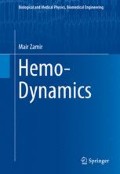Abstract
Solutions of fluid flow problems, to fully determine the dynamics of the fluid, including a mapping of the velocity field and of the relation between the prevailing pressure and flow fields, are possible only in the most simply constructed cases and mostly in the physical sciences. Fluid flow problems in biology, by contrast, are rarely simply constructed and can rarely be solved directly. The problem of flow in a tube, for example, has a simple so called “Poiseuille flow” solution when the tube is rigid, its cross section is perfectly circular, the tube is long enough for the flow to be fully developed, and the fluid is a smooth “continuum” that has the simple rheological properties of a “Newtonian” fluid in which the shear stress is related linearly to the velocity gradients. Barely any of these ideal conditions is met in biological problems involving flow in tubes, most notably the problem of blood flow in arteries which is the subject of this book. Here the fluid is not a smooth continuum but a suspension in plasma of discrete red and other blood cells and, as we saw in the previous chapter, the system does not consist of a single tube but of many millions of tube segments that are joined together in a hierarchical tree structure. The segments are rarely long enough or perfectly circular to support fully developed Poiseuille flow, and the details of flow at their junctions are highly complicated and depend strongly on the exact geometry of each junction. Furthermore, the precise branching structure of the arterial tree or sub-trees within the cardiovascular system can rarely be mapped to the last detail so as to allow a mathematical solution of the flow problem based on a given tree structure as was done in the previous chapter.
Access this chapter
Tax calculation will be finalised at checkout
Purchases are for personal use only
Notes
- 1.
Kreyszig E, 1983. Advanced Engineering Mathematics. Wiley, New York.
- 2.
Kreyszig E, 1983. Advanced Engineering Mathematics. Wiley, New York.
- 3.
See: Milnor WR. Hemodynamics. Williams & Wilkins, Baltimore, 1989.
- 4.
Meriam JL, 1980. Engineering Mechanics, Statics and Dynamics. John Wiley and Sons, New York.
- 5.
Ginsberg JH, Genin J, 1984. Statics and Dynamics. John Wiley and Sons, New York.
- 6.
Cogdell JR, 1999. Foundations of Electric Circuits. Prentice Hall, Upper Saddle River, NJ.
Author information
Authors and Affiliations
Rights and permissions
Copyright information
© 2016 Springer International Publishing Switzerland
About this chapter
Cite this chapter
Zamir, M. (2016). Dynamics of Pulsatile Blood Flow I. In: Hemo-Dynamics. Biological and Medical Physics, Biomedical Engineering. Springer, Cham. https://doi.org/10.1007/978-3-319-24103-6_8
Download citation
DOI: https://doi.org/10.1007/978-3-319-24103-6_8
Published:
Publisher Name: Springer, Cham
Print ISBN: 978-3-319-24101-2
Online ISBN: 978-3-319-24103-6
eBook Packages: Physics and AstronomyPhysics and Astronomy (R0)

